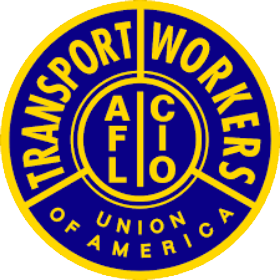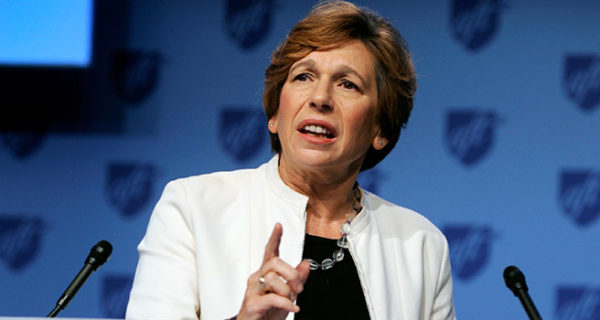WASHINGTON—The average ratio of CEO compensation to their workers’ median pay increased to 299 to 1 at S&P 500 companies in 2020, up from 264:1 in 2019, according to the AFL-CIO’s annual Executive Paywatch figures, released July 14.

“In 2020 on average, CEOs of S&P 500 companies were given a big raise,” AFL-CIO secretary-treasurer Liz Shuler told reporters at a telephone press conference. Their increased compensation, she continued, came despite the country’s worst public-health crisis in a century, 41 million layoffs and a net loss of 9 million jobs, and the country being carried through the COVID-19 pandemic largely by workers.
“That’s what we mean when we say extreme inequality,” Shuler said.
By The Numbers
Average pay for CEOs at S&P 500 companies was $15.5 million, up $700,000 from 2019. Many companies cut CEO’s base salaries, but that was largely for show, said Shuler: Stock-based compensation increased by an average of $1 million, and other executives got “retention bonuses.”
In the Russell 3000 index of the largest 3,000 U.S. companies, average CEO salaries decreased by 4% in 2020, but equity-based compensation increased by 8% and restricted stocks by 11%, said Brandon Rees, deputy director of the AFL-CIO’s Office of Investment.
The figures are based on company proxy statements filed with the federal Securities and Exchange Commission, he explained.
Overall, said Shuler, CEOs’ pay increased by an average of 5% in 2020, and workers’ pay by only 1%. Over the past 10 years, CEO pay at S&P 500 companies has increased by more than $260,000 a year, while the average increase for production and nonsupervisory workers was $957 a year, with their average income reaching $43,512 in 2020.
The most extreme differences came in the “consumer discretionary” sector, where companies typically manufacture goods in low-wage countries overseas and rely on low-wage workers to sell them in the U.S. The clothing brand Abercrombie & Fitch topped the list, with CEO Fran Horowitz making $11,950,000, more than 6,500 times the median worker pay of $1,820. Clothing and toy brands The Gap, Skechers, Mattel, and American Eagle Outfitters all ranked in the most extreme 15, with their CEOs raking in more than 2,000 times their workers’ median pay of $6,000 to $7,200.
The Chipotle Mexican Grill fast-food chain ranked tenth, with CEO Brian Niccol’s $38 million almost 2,900 times its median worker pay of $13,127. Yum China Holdings, which operates KFC, Taco Bell, and Pizza Hut restaurants in China, ranked sixth, with CEO Joey Wat taking in 3,844 times as much as the median worker’s $5,507.
Overall, CEOs in the consumer-discretionary sector made 741 times as much as the median worker, said Rees. In contrast, said Shuler, the ratio among utilities, where 20% of workers are in unions, was 97:1.
Need to Pass the PRO Act
The PRO (Protecting the Right to Organize) Act, passed by the House in March, would reduce that inequality, said Shuler. It would “balance the scales before they break” by restraining employers’ efforts to quash union organizing, such as by establishing penalties for firing union supporters and repealing the 1947 law that enables states to pass “right to work for less” laws, which prohibit labor contracts in which workers have to join unions or contribute to the costs of representation.
The ratio of CEO pay to workers’ is 173:1 at large companies with headquarters in the 27 states that have so-called “right to work” laws, Shuler said, and 133:1 in the 23 “union security” states. Workers’ pay averages 22% lower in the states that ban the union shop, she added.
The bill has been stalled in the Senate by the threat of a Republican-led filibuster. Asked if the AFL-CIO would be willing to cut and paste some provisions of it into a budget-reconciliation bill that could not be filibustered, Shuler answered that the federation as of now is “maintaining that every element of the PRO Act is critical. We’re not willing to start negotiating away benefits.”
The PRO Act would also forbid companies from permanently replacing strikers, as the Spectrum cable-TV company has done in New York. The strike began in March 2017, after 1,800 cable technicians, members of International Brotherhood of Electrical Workers Local 3, rejected the company’s demand to change their health benefits to a high-deductible plan and replace their pensions with a 401(k) plan. It is still going on more than four years later, with Spectrum trying to use strikebreakers’ votes to decertify Local 3.
Thomas Rutledge, CEO of Spectrum’s parent company, Charter Communications, ranked 27th on the AFL-CIO’s executive-pay list, with more than $38.8 million. Only about $2 million of that was in salary; the bulk of it was $30 million in stock-option awards and $6.3 million in “non-equity incentive plan compensation.”
Rutledge made 687 times as much as the company’s median worker in 2020.




1 thought on “CEOs’ Pay Jumped in 2020; Now Almost 300 Times What You Earn!”
The belly of the beast [Wall St. and its CEOs] is famous for its profligate. – so sick that Hitler and Wall St. were close. Unfortunately, our American system seems to solely function on the shadows of capitalism.ie., the popular vote is secondary. And hence, putting our democracy in a state of confusion.
The aristocrats of finance [Merrill Lynch/Morgan Stanley/Goldman Sacks/First Boston etc.] determine the ways of our survival. – business loans/bonds for sewers/highways/hospitals…infrastructure…~ This is the essence of Capital formation.
I think that Capital formation is a good thing. On the flip side of the coin, I’m also convinced that its a wildfire. – as long as our legislators continue to drag their feet/turn the other eye, this wildfire will make the TARP program look minuscule.
I appreciate Rees’s critique and those of our trade union leaders. * The battle for right/fair labor laws is a tough road – THE NEW DEAL[1933-1940] was not an extemporaneous idea. It was more like a humane joinery at best. It’s also important not to lose sight on why the New Deal was born. And why collective bargaining is the other side of the solid bridge.
The PRO ACT is an excellent formula. And it also a compliment to the principles of OUR democracy. – PEOPLE BEFORE PROFIT [ this is not complicated to understand].
hp LiUNA
Steward of the Cement and Concrete Workers local union 20
GOD BLESS America